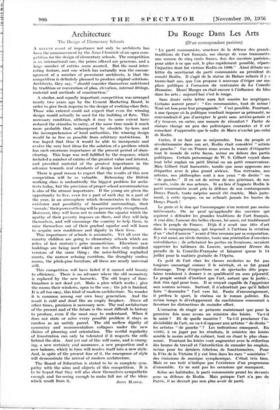Architecture
The Design of Elementary Schools A RECENT event of importance not only to architects has been the announcement by the News Chronicle of an open com- petition for the design of elementary schools. The competition is an international one, the prizes offered are generous, and a large number of entries seem assured. But the most inter- esting feature, and one which has naturally won the encour- agement of a number of prominent architects, is that the competition is definitely planned to produce original solutions. Architects, they say, " should consider themselves unfettered by tradition or convention of plan, elevation, internal fittings, material and methods of construction:' A similar, and equally important, competition was arranged nearly two years ago by the Cement Marketing Board, in order to give fresh impetus to the design of working-class flats. Those who entered could not expect- that- even the winning
design would actually be used -for the building of flats. This necessary condition, although it may to some extent have reduced the stimulus to entry, at the same time made it much more probable that, unhampered by obsolete by-laws and the incomprehension of local authorities, the winning design would be as free as possible from arbitrary restrictions. It was hoped that thus it would be able to incorporate and evolve the very best ideas for the solution of a problem which has such enormous importance at the present period of slum- clearing. This hope was well fulfilled by the response, which included a number of entries of the greatest value and interest, and provided material of the greatest importance in the advance towards real standards of design and planning.
There is good reason to expect that the results of this new competition will be as valuable. Rehousing the British working class is undoubtedly the biggest problem for archi- tects today, but the provision of proper school accommodation is also of the utmost importance. If the young are given the opportunity to live, even for a part of each day in a part of the year, in an atmosphere which demonstrates to them the existence and possibility of beautiful surroundings, their morale,' their power of living will be permanently strengthened. Moreover, they will learn not to endure the squalor which the apathy of their poverty imposes on them, and they will help themselves, and will encourage the country to help them, to raise themselves out of their gradual squalor and will learn to acquire new confidence and dignity in their lives.
This importance of schools is axiomatic. Yet all over the country children are going to, elementary schools which are
relics of last century's grim monasticism. Elsewhere new buildings are being used which are too often only modified versions of the same thing ; the noise-bottling asphalted
courts, the narrow echoing corridors, the draughty sunless rooms, the pitch-pine furniture, all these are nearly universal still.
This competition will have failed if it cannot add beauty to efficiency. There is no advance where the old monastery
is replaced by the new barracks. The old bogey of func- tionalism is not dead yet. Make a plan which works ; give the rooms their windows, open to the sun : the job is finished.
It is all too easy, this kind of modern architecture. No wonder it is common among our own busy generation. And the result is cold and dead like an empty fireplace. Above all other times, precision is necessary now. The real architecture of the present and of the future is the most difficult in history to produce, even if the most easy to understand. When it
does not state or solve -every possible problem it stays as careless as an untidy parcel. The old mellow dignity of symmetry and monumentalism collapses under the new claims of planning and orientation. The restful regularity of fenestration can only be tolerated if it respects the cells behind the skin. And yet out of this will 'come, and is etnerg: ing, a new certainty and assurance, a new proportion and new balance, which in time will resolve itself into a new style. And, in spite of the present fear of it, the emergence of style will demonstrate the arrival of modern architecture.
The Board of Education is stated to be in complete sym- pathy with the aims and objects of this competition. It is to be hoped that they will also show themselves-sympathetic enough and far-seeing enough to make full use of the ideas




























































 Previous page
Previous page